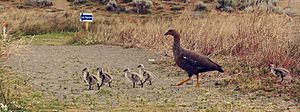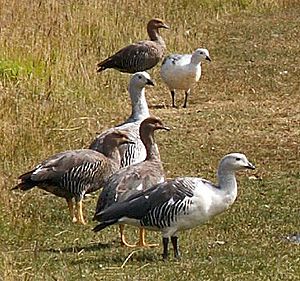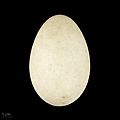Magellan Goose facts for kids
The Upland Goose or Magellan Goose (Chloephaga picta) is a type of sheldgoose. It belongs to the same animal family as ducks, geese, and swans. This bird naturally lives in the southern parts of South America.
Quick facts for kids Magellan Goose |
|
|---|---|
 |
|
| Scientific classification | |
| Kingdom: | |
| Phylum: | |
| Class: | |
| Order: | |
| Family: | |
| Genus: |
Chloephaga
|
| Species: |
C. picta
|
| Binomial name | |
| Chloephaga picta (Gmelin, 1789)
|
|
| Subspecies | |
|
|
| Synonyms | |
Contents
Appearance and Features

These geese are about 60 to 72.5 centimeters (24 to 29 inches) long. They weigh between 2.7 and 3.2 kilograms (6 to 7 pounds).
Male Upland Geese have a white head and chest. Females are brown with black stripes on their wings and yellow feet. Sometimes, people might confuse them with ruddy-headed geese. Adult males also have a special greenish-bronze patch on their inner wing feathers, called a speculum.
Interestingly, in his famous book On the Origin of Species, Charles Darwin wrote about the Upland Goose. He noticed that their webbed feet seemed to be "rudimentary," meaning they weren't fully used for swimming. This suggested to him that these features were leftovers from their ancestors.
Where They Live

Upland Geese live in southern temperate grasslands. You can find them in dry lowlands, pastures, and farm fields. They live from sea level up to about 1,500 meters (4,900 feet) high. There's also a group of these geese that were brought to South Georgia Island, which is a sub-Antarctic island.
Behavior and Diet
The Upland Goose mainly eats plants. They feed on seeds, leaves, stems, and other plant parts. They are very social birds and often gather in huge groups. You might see thousands of them grazing together in one field.
Farmers sometimes consider them pests because they eat the grass meant for cattle and sheep.
Reproduction and Life Cycle
Upland Geese usually breed in areas with thick plants on plains or slopes. This happens mostly in September and October, or in November if they are on the Falkland Islands.
To attract a female, the male goose whistles loudly. The female then responds with softer cackling sounds. These geese are monogamous, meaning they stay with one partner. If a male goose enters another's territory, a serious fight can happen. Males have even been found injured or dead after these fights.
Their nest is built on the ground, hidden by thick plants, often close to water. A female usually lays 5 to 8 eggs. She sits on them for about one month until they hatch. When the chicks hatch, they are covered in soft, greyish-brown down. They don't stay in the nest for long, usually less than a day. They quickly move to a nearby water source or feeding area. The chicks can find their own food right after hatching. They learn to fly in 9 to 10 weeks and become adults when they are about 3 years old.
Images for kids
See also
 In Spanish: Cauquén común para niños
In Spanish: Cauquén común para niños


